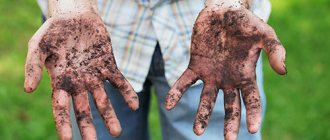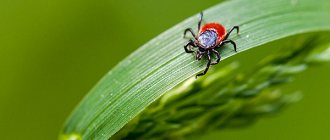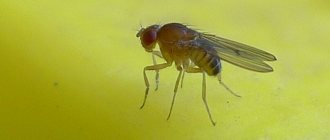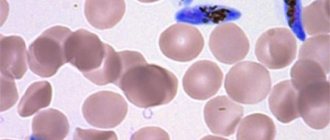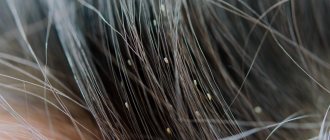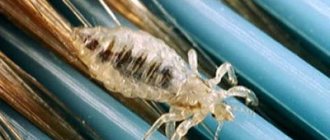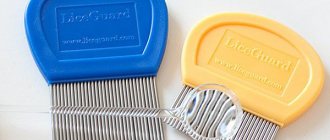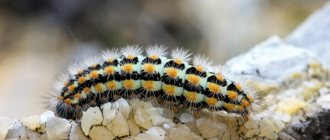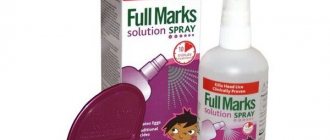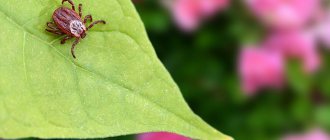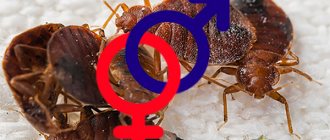- about the author
- VK profile
Svetlana Tarasova
Hairdresser-stylist with more than 8 years of experience, expert in the field of haircuts, styling, hair care, coloring.
Lice are arthropod insects that cause a parasitic skin disease - pediculosis. This disease is the most common among people and regardless of the economic level of the country. According to Rospotrebnadzor, about 300 thousand cases of the disease are recorded in Russia every year.
Methods of infection and signs of lice
All methods of lice infection involve contact with a host. This often happens in crowded conditions (in a store, transport, bathhouse) and in the absence of a basic level of hygiene.
REFERENCE. You cannot get lice from animals. Animals carry species of lice that do not parasitize humans.
Head lice infestation occurs:
- through personal hygiene items (combs, towels, hats);
- through bed linen;
- close contact with a person with lice;
- in public places (bathhouse, sauna, swimming pool, kindergartens and camps).
Body lice infestation occurs:
- through the use of personal belongings of a person infected with head lice;
- in places with a large number of people;
- through trying on clothes in stores or markets.
Pubic lice infestation occurs:
- through sexual contact;
- in public places (sauna, swimming pool, solarium);
- use of the patient's personal belongings;
- any contact with the skin of an infected person.
REFERENCE. Thanks to the fashion for shaved pubes, the number of pubic lice has recently decreased as the insects have lost their natural habitat.
The main sign of lice infestation is persistent and severe itching at the bite sites . Insect saliva contains toxic substances that cause skin irritation. Symptoms also include:
- bite marks on the hairy parts of the human body;
- swollen lymph nodes;
- crusts on the human body (localization depending on the type);
- itching, urticaria (in the presence of body lice);
- small spots on underwear (if there are pubic lice);
- blisters, scratching and rashes on the body;
- the presence of nits (eggs are easier to detect than adults);
- presence of lice (comb hair over a light surface).
REFERENCE. If you shake your hair, the nits will not fall off; they hold on tightly. When a nit is crushed, you can hear a characteristic click.
general description
A head louse is a small blood-sucking parasitic insect that lives only on the human body and feeds on blood.
The insect develops very quickly, in just three weeks, thanks to stable and comfortable living conditions.
Stability is ensured by the fact that most individuals spend their entire lives on the body of one person , and comfort is ensured by the constant availability of freely available food (blood).
Each time, before moving to a new stage of development, lice molt .
This is due to the fact that the chitinous cover does not have time to grow with the body and, simply, breaks.
The molting process takes about 5 minutes.
Types of lice
There are more than 500 species of lice in mammals. There are two types of parasites on humans:
- human louse;
- pubic louse.
The human louse has two forms of parasites: head and body louse. They are carriers of typhus: typhus and relapsing.
- The head louse is named after its habitat - it lives and reproduces in the scalp: hair, beard, mustache, eyebrows. It is the most common parasite and can occur in people living in good sanitary conditions. The louse drinks blood almost continuously and cannot live without hair on its head.
- Body louse is sometimes called bed or linen louse. She climbs and lives in the folds of clothes, bedding and underwear – wherever there is frequent and close contact with human skin. They feed most often at night, and lay eggs in clothing fabrics.
REFERENCE. The body louse arose as a result of the development of human civilization. It is adapted to life on clothing fabrics, but not on the body.
- The pubic louse lives in the groin area and adjacent genitals. Sometimes it can settle in the armpits. Its habitat is related to the structure of the hair in the pubic area (it has a triangular cross-section); such a louse will not be able to stay on a head with round hair. This type of lice prefers to stay in one place. The pubic louse eats with long breaks, and can live for 2 days without bleeding.
Life cycle of lice
Lice are insects with incomplete metamorphosis. This means that they do not have the normal larval stage of other insects. The female begins to mate within 24-48 hours after molting.
The life cycle of lice is as follows:
- Egg (nit).
- Larva.
- Nymph I.
- Nymph II.
- Imago (adult).
Incubation period
The entire development process from a nit to a mature insect takes about 15-16 days. It can take up to two months.
- Larva develops within 24 hours at a favorable temperature of 30 degrees. Development may slow down to 10 days if the ambient temperature is 10 degrees.
- Nymph I It develops for 5 days, after which it sheds.
- Nymph II develops within 8 days and then turns into an imago (adult).
- Imago. An adult lives on average 30 days. The entire development process from a nit to a mature insect takes about 15-16 days.
What determines the speed of the incubation period?
The incubation period for nits will be minimal if conditions are favorable for them: temperature 30-31 degrees, humidity – average. If the temperature rises above 40 degrees or drops below 22, then the development of eggs stops .
The larvae hatch from the nits:
- for 8 days at a temperature of 25-26 degrees;
- in 5-6 days at a temperature of 32-33 degrees.
Stages of larval development
During hatching from the egg, the nit cap on one side comes off. The louse begins to suck in air, which passes through the anus and accumulates in the lower part of the nit. The accumulated air gradually pushes the larva out, after which it begins to crawl and drink blood.
The larva looks like an adult insect, only small in size. She has no genitals. The larval stage lasts up to three days, during which three moults occur. Lice eggs reach 1.5 mm in length and 0.7 mm in width. They are covered with a hard shell and have a pear-shaped or oval shape. Egg color: white or yellowish.
What does an adult look like?
A louse is a small arthropod insect. On the side of the abdominal cavity, lice have a cone-shaped mouth opening with sparse hooks with which the louse clings to the body, hair and clothing (depending on the species). The piercing-sucking type of mouthparts of lice are retracted into the capsule when the insect is not feeding, and comes out when consuming food. Lice do not have the makings of wings: they can only crawl.
The legs of lice are five-segmented, tenacious, of a grasping type, due to which the louse holds well on human hair and clothing. The shins have spines and protrusions, and the paws have a smooth, sickle-shaped claw. Moving, the louse grabs a person's hair with this claw and presses it to the shin.
All types of lice differ slightly from each other in appearance:
- In head lice, females reach 4 mm in length, and males - 3 mm. They have a translucent and gray-yellow flattened body.
- Body lice are distinguished by a dull-dirty white body, which reaches a length of 5 mm in females, and 3-4 mm in males.
- Pubic lice are the smallest human parasites - up to 1.5 mm in females, and up to 1 mm in males. The bodies of insects are light brown. Their bodies are wider than those of other species.
General information
A louse is an insect that parasitizes the hair part of the human body. There are 3 types of lice:
- head;
- pubic;
- wardrobe
The first two species live only in certain areas, since the structure of their paws does not allow them to move on other surfaces. The life cycle of a louse from hatching an egg to its deposition, provided the environment is favorable, is only 2 weeks and 2 days. And if the environment is not at all favorable, but still allows reproduction, it lasts only a month. Thus, within a few months after the parasite has settled, a person will have a huge population of insects. And after six months, the life of the owner will become unbearable due to the troubles that these parasites can bring.
Although the life of a louse is not very long, during this period it is capable of producing an incredible number of its own kind.
The entire life cycle of an insect consists of several stages of development, each of which has its own characteristics. An interesting fact is that the reproduction and developmental stages of all species of these insects are almost the same and differ in minor details.
The louse differs significantly from other parasitic pests in its incomplete transformation. The larva is not typical, like other insects. There is no difference between larvae and adults in their feeding method and appearance.
After the last “larval” moult occurs, the female is ready to mate. Within a few hours after maturation, she lays eggs. Lice are not susceptible to developmental delays, as they have no food restrictions. They feed approximately every 2 hours. The maximum time without food reaches 10 hours.
The parasite lays eggs on the hair. They are protected in a special sticky case, which is firmly attached and prevents the egg from falling. If you examine the hair of an infected person, you will notice white stripes on the hair located at different intervals from each other. Microscopic examination clearly shows the structure of the case in which the egg matures. An egg in a case is called a nit.
Lice reproduction. Sexual cycle of lice
Lice reproduce by laying nits (eggs). The first mating occurs 12 hours after the first bite and blood drinking. Mating lasts from 10 minutes to an hour. During this process, the female receives the male's seed, which she uses during her life. Several hours pass from the mating process to the complete maturation of the larva.
REFERENCE. Only a well-fed insect can lay eggs. A hungry louse stops procreation.
Two days after the last molting of the larvae, eggs are laid:
- The egg is hatched into the unpaired hatchery sleeve through the oviducts.
- Before the egg, the secretion of the gonads emerges from the genital tract, with which the female covers her hair.
- When the egg emerges, it is attached to the hair by this secretion, and the female crawls away further.
What conditions are required for reproduction?
Temperature limits for lice reproduction are from 22 to 44 degrees Celsius . The most optimal temperature for rapid development of larvae is 30 degrees Celsius. Dry air prevents the development of larvae and reduces the lifespan of adults.
Their large numbers contribute to the rapid reproduction of lice . If the male and female do not have to look for each other for a long time, then procreation becomes a quick process.
How quickly do head lice reproduce?
Under favorable conditions (ambient temperature and optimal air humidity), the number of lice colonies increases significantly in 3-4 weeks.
A louse, falling on a person, begins to bite him within the first few hours. But while there are few adults, the bites are not felt or no attention is paid to them. A month after this, symptoms of the development of the disease begin to be felt due to an increase in the number of insects.
How many eggs do they lay?
Females lay 140 to 350 eggs during their lifetime. During the day, she is able to lay no more than 4 eggs (for head lice) and no more than 14 (for body lice), regardless of mating. This happens at their optimal temperature of 28-30 degrees. If the degrees drop to 15, the process does not occur.
Peculiarities of reproduction of different types of lice
Reproduction of lice depending on the type:
- A head louse lays 4 eggs per day. The development of larvae occurs at a temperature of 33-35 degrees - from 5 to 9 days. Over the course of her life, a female can lay up to 140 eggs. Females attach eggs to human hair.
- A body louse can lay up to 14 eggs in a day, and up to 300 in its entire life. The larvae develop at a temperature of 29-37 degrees, going through the full life cycle in 16 days. The insect lays eggs in underwear and folds of clothing.
- Female pubic lice lay up to 4 eggs per day, which are attached to the hair on the human body: the groin area, armpits, beard and chest in men.
Control measures
Preventive measures to combat head lice include:
- Wash your hair at least once a week;
- Refusal to use other people's hats or combs;
- Systematic cutting and daily combing of scalp hair;
- Systematic cleaning of premises;
- Compliance with sanitary and hygienic rules in baths, laundries, hairdressers;
- Sanitary supervision of crowded places (dormitories, hotels, train stations, carriages);
- Examination for pediculosis of children attending kindergartens;
- Examination for pediculosis of persons admitted for inpatient treatment in medical institutions.
Detection of lice at any stage of development requires simultaneous disinfestation measures to destroy pests both on a person’s head and on his things.
Physical methods
Processing of hats, pillowcases, other items of clothing and bed linen: boiling, ironing with a hot iron, treatment in disinfection chambers.
Mechanical methods
Hair washing, combing, short haircut or shaving.
Chemical method
On the human head: treatment of the head with pediculicides (usually pyrethroids) in the form of lotions and emulsions. When treating the head with shampoos (that do not have ovicidal properties), it must be repeated after 7-10 days.
We suggest you read: Where do lice come from on an adult’s head?
How long do they live
The maximum lifespan of lice is 2 months. Insect lifespan:
- head lice – 4 weeks;
- body lice – 46 days (in females) and 32 days (in males);
- pubic lice – 20 days (females), 22 days (males).
Lice can live in water for up to two days, and their eggs can live for 3 days. And without food, lice have a short lifespan - about 2 days. Hatched larvae, without access to food, die after 12-48 hours.
What type of hair do lice prefer?
Contrary to popular belief that lice infest hair that has been unwashed for a long time, insects prefer clean hair and scalp. In such conditions it is easier for them to feed. But it is dirty hair and poor hygiene that contribute to its rapid spread. Anyone can become infected, regardless of origin, race or hair quality.
Long flowing hair is like a convenient path for insects when moving from one person to another . In addition, lice on such hair are difficult to notice and get rid of.
Traditional methods
There are many folk remedies to combat lice. They are preferred for use in cases of head lice infestation in children. It is believed that folk remedies are less harmful and cannot harm health.
To combat lice use:
- washing hair with kerosene;
- vinegar wrap;
- rinsing with tansy infusion or wormwood decoction;
- masks made from crushed cranberries;
- masks made from onion pulp.
Kerosene and vinegar are good because they not only kill insects, but also clean the hair roots and dissolve the substance that attaches nits to the hairs. After this treatment, it is easier to remove them from the hair.
The danger of these methods is that, firstly, you need to know the exact concentration and time of exposure, otherwise you can burn your scalp or get an allergic reaction. Secondly, kerosene and vinegar damage hair; it will take a long time to restore it after such treatment. Traditional methods require repeated use. The fight against lice can take a long time, and during this time new individuals will appear from the nits remaining on the hair.
Dust soap is effective against lice and nits. They wash their hair with it several times for several days in a row. It is necessary to rinse your hair well and comb out dead insects and eggs from your hair each time.
When should you see a doctor?
Over the past decades, lice have developed resistance to the chemicals used to remove them. In rare cases, lice can transmit typhus or fever, but advanced cases can cause pyoderma and purulent skin lesions. To prevent this, at the first sign of lice detection, you need to contact your local physician.
Do you see a doctor if you are diagnosed with lice?
Not really
Complications of pediculosis:
- conjunctivitis;
- inflammation of the edges of the eyelids;
- inflammation of the lymph nodes;
- streptococcal infections;
- bacterial infection (pyoderma) of the face, behind-the-ear areas and scalp;
- typhus (rare).
The doctor will determine the type of lice parasitizing on humans and select the optimal treatment . In addition, the incubation period of head lice is a month. And being in a group with a large number of people can provoke an outbreak of head lice, since the symptoms are not immediately noticeable.
The louse, as an insect, is very interesting for scientists to study. But for people it poses a danger of contracting lice. To avoid illness, you need to regularly carry out hygiene procedures, not use other people’s hygiene items and regularly wash your bed linen. In this case, the risk of infection is reduced to zero. And you don’t have to study the insect on your comb; it’s better to leave this to the specialists.
- about the author
- VK profile
Effective treatment
An effective way to get rid of lice is to use special lotions or sprays. These drugs - pediculicides - can get rid of lice in one application. If the infection is severe, it will take longer.
We offer medications for treatment: Medilis-BIO, Medilis-Malathion, Medilis-Permifen, Medilis-Super. Lotions are rubbed into the scalp, left on the hair for a certain time required for effect, after which the head is thoroughly washed. To remove nits and dead insects remaining in the hair, the hair must be combed thoroughly.
A spray differs from a lotion only in the form of application. Spraying the head is a more dangerous method, since with such application you can inhale a dangerous substance. It is not dangerous to humans in itself, but in high concentrations it can cause allergic reactions. Spray products are not recommended for use in the treatment of children, pregnant women, people suffering from asthma and respiratory diseases.
When using any means, you must follow safety precautions, in particular, protect your eyes from contact with toxic substances. Leave the product on your head for no more than the permitted time to prevent skin irritation and chemical burns. When processing, it is necessary to provide access to fresh air into the room; after processing, the room must be ventilated.
Each drug has instructions for use, which must be strictly followed.
These products are not suitable for treating pregnant and lactating women and children under 5 years of age. For them, it is better to use less dangerous folk remedies.
When using any products - professional or folk - in addition to the head, you need to treat combs, towels - everything that can come into contact with the hair and where lice can move.
